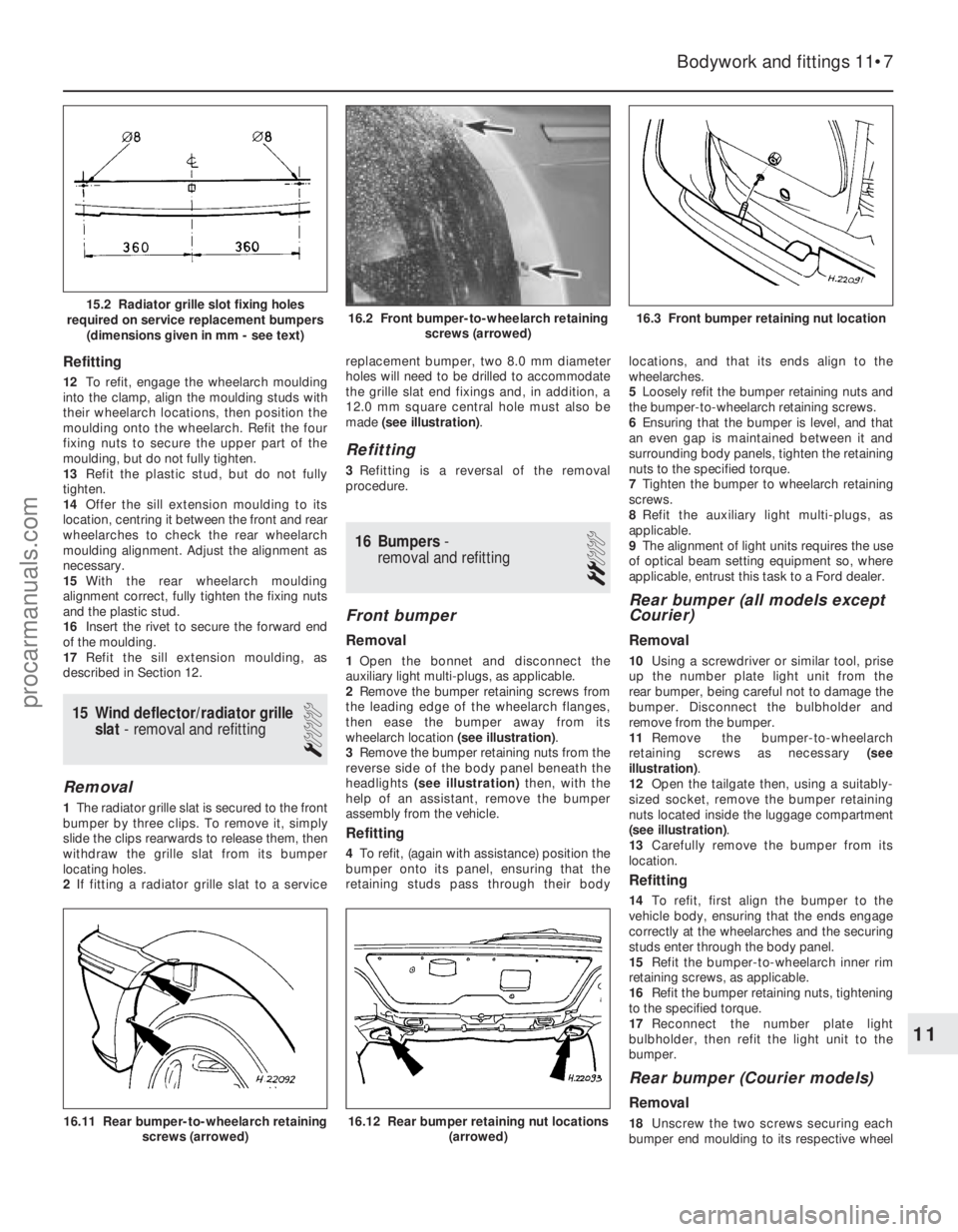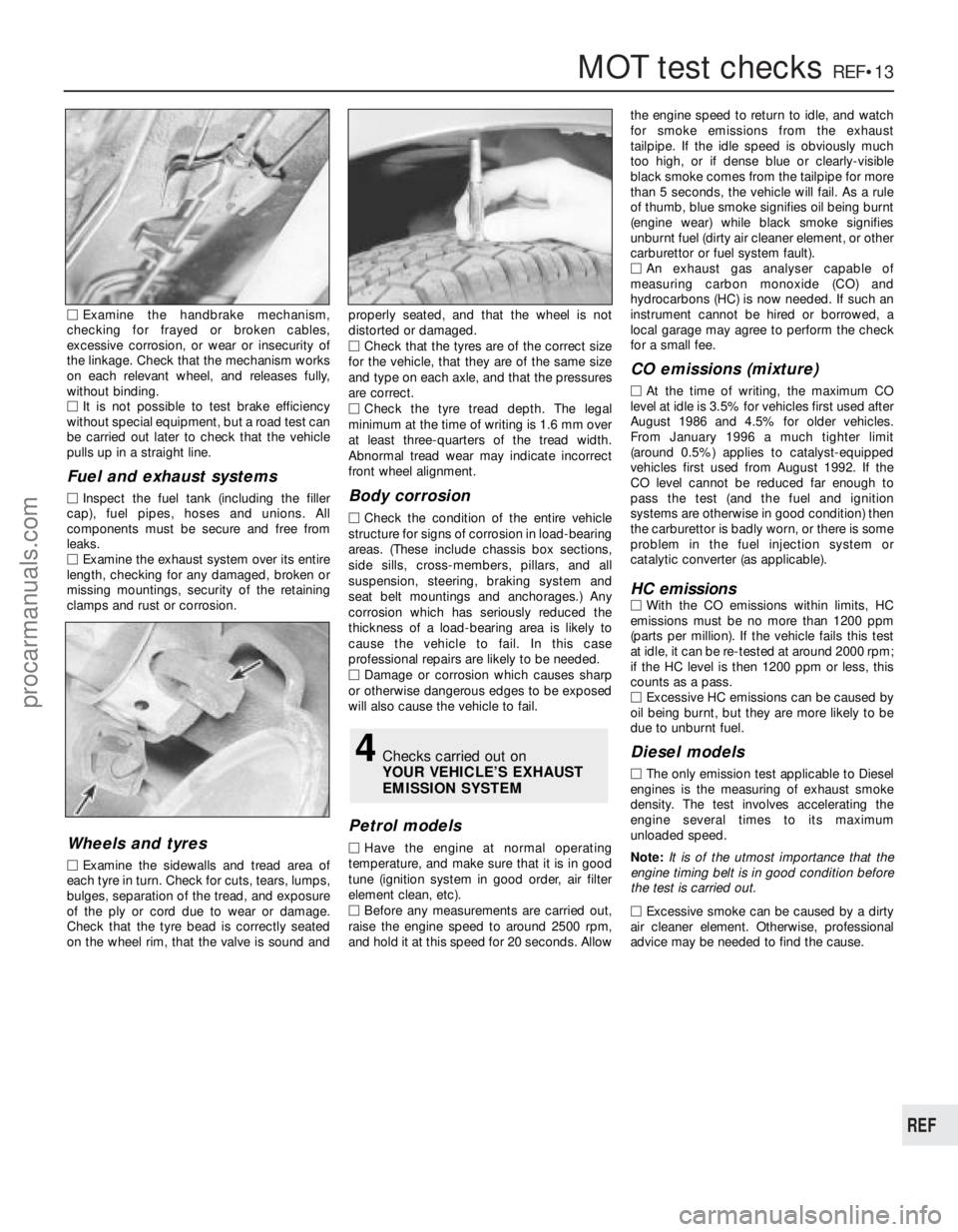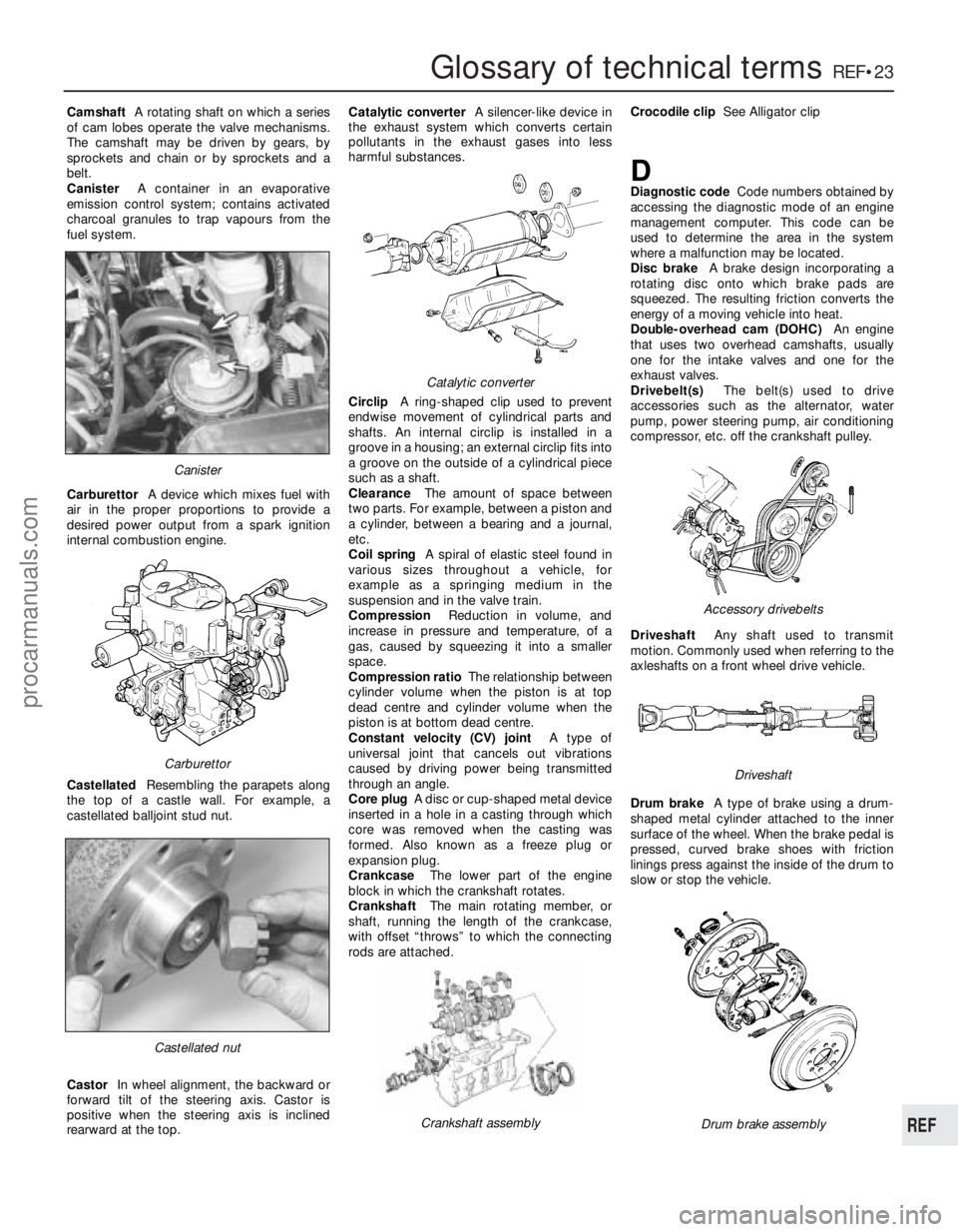1989 FORD FIESTA wheel size
[x] Cancel search: wheel sizePage 218 of 296

Refitting
12To refit, engage the wheelarch moulding
into the clamp, align the moulding studs with
their wheelarch locations, then position the
moulding onto the wheelarch. Refit the four
fixing nuts to secure the upper part of the
moulding, but do not fully tighten.
13 Refit the plastic stud, but do not fully
tighten.
14 Offer the sill extension moulding to its
location, centring it between the front and rear
wheelarches to check the rear wheelarch
moulding alignment. Adjust the alignment as
necessary.
15 With the rear wheelarch moulding
alignment correct, fully tighten the fixing nuts
and the plastic stud.
16 Insert the rivet to secure the forward end
of the moulding.
17 Refit the sill extension moulding, as
described in Section 12.
15 Wind deflector/radiator grille slat - removal and refitting
1
Removal
1The radiator grille slat is secured to the front
bumper by three clips. To remove it, simply
slide the clips rearwards to release them, then
withdraw the grille slat from its bumper
locating holes.
2 If fitting a radiator grille slat to a service replacement bumper, two 8.0 mm diameter
holes will need to be drilled to accommodate
the grille slat end fixings and, in addition, a
12.0 mm square central hole must also be
made
(see illustration) .
Refitting
3Refitting is a reversal of the removal
procedure.
16 Bumpers -
removal and refitting
2
Front bumper
Removal
1 Open the bonnet and disconnect the
auxiliary light multi-plugs, as applicable.
2 Remove the bumper retaining screws from
the leading edge of the wheelarch flanges,
then ease the bumper away from its
wheelarch location (see illustration).
3 Remove the bumper retaining nuts from the
reverse side of the body panel beneath the
headlights (see illustration) then, with the
help of an assistant, remove the bumper
assembly from the vehicle.
Refitting
4 To refit, (again with assistance) position the
bumper onto its panel, ensuring that the
retaining studs pass through their body locations, and that its ends align to the
wheelarches.
5
Loosely refit the bumper retaining nuts and
the bumper-to-wheelarch retaining screws.
6 Ensuring that the bumper is level, and that
an even gap is maintained between it and
surrounding body panels, tighten the retaining
nuts to the specified torque.
7 Tighten the bumper to wheelarch retaining
screws.
8 Refit the auxiliary light multi-plugs, as
applicable.
9 The alignment of light units requires the use
of optical beam setting equipment so, where
applicable, entrust this task to a Ford dealer.
Rear bumper (all models except
Courier)
Removal
10 Using a screwdriver or similar tool, prise
up the number plate light unit from the
rear bumper, being careful not to damage the
bumper. Disconnect the bulbholder and
remove from the bumper.
11 Remove the bumper-to-wheelarch
retaining screws as necessary (see
illustration) .
12 Open the tailgate then, using a suitably-
sized socket, remove the bumper retaining
nuts located inside the luggage compartment
(see illustration) .
13 Carefully remove the bumper from its
location.
Refitting
14 To refit, first align the bumper to the
vehicle body, ensuring that the ends engage
correctly at the wheelarches and the securing
studs enter through the body panel.
15 Refit the bumper-to-wheelarch inner rim
retaining screws, as applicable.
16 Refit the bumper retaining nuts, tightening
to the specified torque.
17 Reconnect the number plate light
bulbholder, then refit the light unit to the
bumper.
Rear bumper (Courier models)
Removal
18 Unscrew the two screws securing each
bumper end moulding to its respective wheel
Bodywork and fittings 11•7
16.2 Front bumper-to-wheelarch retaining screws (arrowed)15.2 Radiator grille slot fixing holes
required on service replacement bumpers (dimensions given in mm - see text)
16.12 Rear bumper retaining nut locations (arrowed)16.11 Rear bumper-to-wheelarch retainingscrews (arrowed)
16.3 Front bumper retaining nut location
11
1595Ford Fiesta Remakeprocarmanuals.com
http://vnx.su
Page 279 of 296

1595 Ford Fiesta Remake
MOT test checksREF•13
REF
MExamine the handbrake mechanism,
checking for frayed or broken cables,
excessive corrosion, or wear or insecurity of
the linkage. Check that the mechanism works
on each relevant wheel, and releases fully,
without binding.
M It is not possible to test brake efficiency
without special equipment, but a road test can
be carried out later to check that the vehicle
pulls up in a straight line.
Fuel and exhaust systems
M Inspect the fuel tank (including the filler
cap), fuel pipes, hoses and unions. All
components must be secure and free fr om
leaks.
M Examine the exhaust system over its entire
length, checking for any damaged, broken or
missing mountings, security of the retaining
clamps and rust or corrosion.
Wheels and tyres
M Examine the sidewalls and tread area of
each tyre in turn. Check for cuts, tears, lumps,
bulges, separation of the tread, and exposure
of the ply or cord due to wear or damage.
Check that the tyre bead is correctly seated
on the wheel rim, that the valve is sound and pr
operly seated, and that the wheel is not
distorted or damaged.
M Check that the tyres are of the correct size
for the vehicle, that they are of the same size
and type on each axle, and that the pressur es
ar e correct.
M Check the tyre tread depth. The legal
minimum at the time of writing is 1.6 mm over
at least three-quarters of the tread width.
Abnormal tread wear may indicate incorrect
fr ont wheel alignment.
Body corrosion
M Check the condition of the entire vehicle
structur e for signs of corrosion in load-bearing
ar eas. (These include chassis box sections,
side sills, cross-members, pillars, and all
suspension, steering, braking system and
seat belt mountings and anchorages.) Any
corrosion which has seriously reduced the
thickness of a load-bearing area is likely to
cause the vehicle to fail. In this case
pr ofessional repairs are likely to be needed.
M Damage or corrosion which causes sharp
or otherwise dangerous edges to be exposed
will also cause the vehicle to fail.
Petrol models
M Have the engine at normal operating
temperatur e, and make sure that it is in good
tune (ignition system in good order, air filter
element clean, etc).
M Befor e any measurements are carried out,
raise the engine speed to around 2500 rpm,
and hold it at this speed for 20 seconds. Allow the engine speed to return to idle, and watch
for smoke emissions from the exhaust
tailpipe. If the idle speed is obviously much
too high, or if dense blue or clearly-visible
black smoke comes from the tailpipe for more
than 5 seconds, the vehicle will fail. As a rule
of thumb, blue smoke signifies oil being burnt
(engine wear) while black smoke signifies
unbur nt fuel (dirty air cleaner element, or other
carbur ettor or fuel system fault).
M An exhaust gas analyser capable of
measuring carbon monoxide (CO) and
hydr ocarbons (HC) is now needed. If such an
instrument cannot be hired or borrowed, a
local garage may agree to perform the check
for a small fee.
CO emissions (mixture)
M At the time of writing, the maximum CO
level at idle is 3.5% for vehicles first used after
August 1986 and 4.5% for older vehicles.
Fr om January 1996 a much tighter limit
(ar ound 0.5%) applies to catalyst-equipped
vehicles first used from August 1992. If the
CO level cannot be reduced far enough to
pass the test (and the fuel and ignition
systems are otherwise in good condition) then
the carburettor is badly worn, or there is some
pr oblem in the fuel injection system or
catalytic converter (as applicable).
HC emissionsM With the CO emissions within limits, HC
emissions must be no more than 1200 ppm
(parts per million). If the vehicle fails this test
at idle, it can be re-tested at around 2000 rpm;
if the HC level is then 1200 ppm or less, this
counts as a pass.
M Excessive HC emissions can be caused by
oil being burnt, but they are more likely to be
due to unburnt fuel.
Diesel models
M The only emission test applicable to Diesel
engines is the measuring of exhaust smoke
density . The test involves accelerating the
engine several times to its maximum
unloaded speed.
Note: It is of the utmost importance that the
engine timing belt is in good condition before
the test is carried out.
M
Excessive smoke can be caused by a dirty
air cleaner element. Otherwise, professional
advice may be needed to find the cause.
4Checks carried out on
YOUR VEHICLE’S EXHAUST
EMISSION SYSTEM
procarmanuals.com
http://vnx.su
Page 289 of 296

1595 Ford Fiesta Remake
Glossary of technical termsREF•23
REF
CamshaftA rotating shaft on which a series
of cam lobes operate the valve mechanisms.
The camshaft may be driven by gears, by
spr ockets and chain or by sprockets and a
belt.
Canister A container in an evaporative
emission control system; contains activated
char coal granules to trap vapours from the
fuel system.
Carburettor A device which mixes fuel with
air in the proper proportions to provide a
desir ed power output from a spark ignition
inter nal combustion engine.
Castellated Resembling the parapets along
the top of a castle wall. For example, a
castellated balljoint stud nut.
Castor In wheel alignment, the backward or
forwar d tilt of the steering axis. Castor is
positive when the steering axis is inclined
rearwar d at the top. Catalytic converter
A silencer-like device in
the exhaust system which converts certain
pollutants in the exhaust gases into less
harmful substances.
Circlip A ring-shaped clip used to prevent
endwise movement of cylindrical parts and
shafts. An internal circlip is installed in a
gr oove in a housing; an external circlip fits into
a groove on the outside of a cylindrical piece
such as a shaft.
Clearance The amount of space between
two parts. For example, between a piston and
a cylinder, between a bearing and a journal,
etc.
Coil spring A spiral of elastic steel found in
various sizes throughout a vehicle, for
example as a springing medium in the
suspension and in the valve train.
Compression Reduction in volume, and
incr ease in pressure and temperature, of a
gas, caused by squeezing it into a smaller
space.
Compr ession ratio The relationship between
cylinder volume when the piston is at top
dead centre and cylinder volume when the
piston is at bottom dead centre.
Constant velocity (CV) joint A type of
universal joint that cancels out vibrations
caused by driving power being transmitted
thr ough an angle.
Cor e plug A disc or cup-shaped metal device
inserted in a hole in a casting through which
cor e was removed when the casting was
formed. Also known as a freeze plug or
expansion plug.
Crankcase The lower part of the engine
block in which the crankshaft rotates.
Crankshaft The main rotating member, or
shaft, running the length of the crankcase,
with offset “throws” to which the connecting
r ods are attached. Crocodile clip
See Alligator clip
DDiagnostic code Code numbers obtained by
accessing the diagnostic mode of an engine
management computer. This code can be
used to determine the area in the system
wher e a malfunction may be located.
Disc brake A brake design incorporating a
r otating disc onto which brake pads are
squeezed. The resulting friction converts the
ener gy of a moving vehicle into heat.
Double-overhead cam (DOHC) An engine
that uses two overhead camshafts, usually
one for the intake valves and one for the
exhaust valves.
Drivebelt(s) The belt(s) used to drive
accessories such as the alternator, water
pump, power steering pump, air conditioning
compressor , etc. off the crankshaft pulley.
Driveshaft Any shaft used to transmit
motion. Commonly used when referring to the
axleshafts on a front wheel drive vehicle.
Drum brake A type of brake using a drum-
shaped metal cylinder attached to the inner
surface of the wheel. When the brake pedal is
pr essed, curved brake shoes with friction
linings press against the inside of the drum to
slow or stop the vehicle.
Castellated nut
Catalytic converter
Crankshaft assembly
Carburettor
Canister
Drum brake assembly
Accessor y drivebelts
Driveshaft
procarmanuals.com
http://vnx.su
Page 291 of 296

1595 Ford Fiesta Remake
Glossary of technical termsREF•25
REF
JJump startStarting the engine of a vehicle
with a discharged or weak battery by
attaching jump leads from the weak battery to
a charged or helper battery.
LLoad Sensing Proportioning Valve (LSPV) A
brake hydraulic system control valve that
works like a proportioning valve, but also
takes into consideration the amount of weight
carried by the rear axle.
Locknut A nut used to lock an adjustment
nut, or other threaded component, in place.
For example, a locknut is employed to keep
the adjusting nut on the rocker arm in
position.
Lockwasher A form of washer designed to
pr event an attaching nut from working loose.
MMacPherson strut A type of front
suspension system devised by Earle
MacPherson at Ford of England. In its original
form, a simple lateral link with the anti-roll bar
cr eates the lower control arm. A long strut - an
integral coil spring and shock absorber - is
mounted between the body and the steering
knuckle. Many modern so-called MacPherson
strut systems use a conventional lower A-arm
and don’t rely on the anti-roll bar for location. Multimeter An electrical test instrument with
the capability to measure voltage, current and
resistance.
NNOx Oxides of Nitrogen. A common toxic
pollutant emitted by petrol and diesel engines
at higher temperatures.
OOhm The unit of electrical resistance. One
volt applied to a resistance of one ohm will
pr oduce a current of one amp.
Ohmmeter An instrument for measuring
electrical resistance.
O-ring A type of sealing ring made of a
special rubber-like material; in use, the O-ring
is compressed into a groove to provide the
sealing action. Overhead cam (ohc) engine
An engine with
the camshaft(s) located on top of the cylinder
head(s).
Overhead valve (ohv) engine An engine with
the valves located in the cylinder head, but
with the camshaft located in the engine block.
Oxygen sensor A device installed in the
engine exhaust manifold, which senses the
oxygen content in the exhaust and converts
this information into an electric current. Also
called a Lambda sensor.
PPhillips screw A type of screw head having a
cr oss instead of a slot for a corresponding
type of screwdriver.
Plastigage A thin strip of plastic thread,
available in different sizes, used for measuring clearances. For example, a strip of Plastigage
is laid across a bearing journal. The parts areassembled and dismantled; the width of the
crushed strip indicates the clearance between
jour nal and bearing.
Pr opeller shaft The long hollow tube with
universal joints at both ends that carries
power from the transmission to the differential on front-engined rear wheel drive vehicles.
Pr oportioning valve A hydraulic control
valve which limits the amount of pressure to
the rear brakes during panic stops to prevent
wheel lock-up.
RRack-and-pinion steering A steering system
with a pinion gear on the end of the steering
shaft that mates with a rack (think of a geared
wheel opened up and laid flat). When the
steering wheel is turned, the pinion turns,
moving the rack to the left or right. This
movement is transmitted through the track
r ods to the steering arms at the wheels.
Radiator A liquid-to-air heat transfer device
designed to reduce the temperature of the
coolant in an internal combustion engine
cooling system.
Refrigerant Any substance used as a heat
transfer agent in an air-conditioning system.
R-12 has been the principle refrigerant for
many years; recently, however, manufacturers
have begun using R-134a, a non-CFC
substance that is considered less harmful to the ozone in the upper atmosphere.
Rocker arm
A lever arm that rocks on a shaft
or pivots on a stud. In an overhead valve
engine, the rocker arm converts the upward
movement of the pushrod into a downward
movement to open a valve.
Rotor In a distributor, the rotating device
inside the cap that connects the centre
electr ode and the outer terminals as it turns,
distributing the high voltage from the coil
secondary winding to the proper spark plug.
Also, that part of an alternator which rotates
inside the stator. Also, the rotating assembly
of a turbocharger, including the compressor
wheel, shaft and turbine wheel.
Runout The amount of wobble (in-and-out
movement) of a gear or wheel as it’ s rotated.
The amount a shaft rotates “out-of-true.” The
out-of-r ound condition of a rotating part.
SSealant A liquid or paste used to prevent
leakage at a joint. Sometimes used in
conjunction with a gasket.
Sealed beam lamp An older headlight design
which integrates the reflector, lens and
filaments into a hermetically-sealed one-piece
unit. When a filament burns out or the lens
cracks, the entire unit is simply replaced.
Serpentine drivebelt A single, long, wide
accessory drivebelt that’s used on some
newer vehicles to drive all the accessories,
instead of a series of smaller, shorter belts.
Serpentine drivebelts are usually tensioned by
an automatic tensioner.
Shim Thin spacer, commonly used to adjust
the clearance or relative positions between
two parts. For example, shims inserted into or
under bucket tappets control valve
clearances. Clearance is adjusted by
changing the thickness of the shim.
Slide hammer A special puller that screws
into or hooks onto a component such as a
shaft or bearing; a heavy sliding handle on the
shaft bottoms against the end of the shaft to
knock the component free.
Sprocket A tooth or projection on the
periphery of a wheel, shaped to engage with a
chain or drivebelt. Commonly used to refer to
the sprocket wheel itself.
Starter inhibitor switch On vehicles with an
O-ring
Serpentine drivebelt
Plastigage
procarmanuals.com
http://vnx.su